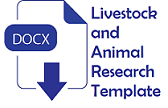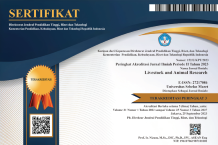The evaluation of the use of jack bean (Canavalia ensiformis) and protease enzyme on the broiler diet with the different level of protein
Abstract
Objective: This study evaluated the use of jack beans (Canavalia ensiformis) and protease enzymes in broiler chicken feed. The protein levels on carcasses and the efficiency of the diet were assessed based on protein efficiency ratio, nitrogen retention, percentage of immunity organs, and feed economic analysis based on Income Overfeed Conversion.
Methods: The factorial complete randomized design (CRD) was employed in this study, piloting three treatment factors: protein level (22% and 19.5%), protein source material (basal diet and jack bean), and the use of enzymes (without enzymes and protease supplementation). Moreover, three replications were conducted, consisting of two samples of broiler chickens per replication. Forty-eight male broiler chickens from 240 populations that had previously been reared for 28 days were taken as the sample of the study.
Result: The results showed that the use of jack beans significantly decreased the dress body weight (P<0.05), undress body weight, and carcass weight of broiler chickens. In addition, the weight significantly increased IOFC by (P<0.01). The use of protease enzymes significantly (P<0.05) increased Retention Nitrogen, Protein Eficiency Ratio, and carcass. The feed protein level decreased substantially by (P<0.01). It reduced protein consumption, RN, PER, dress, undress, and carcass body weight. The use of jack bean did not affect the broiler's immune organ size.
Conclusion: The use of protease enzymes in diets with low protein levels can produce dress body weight, carcass body weight, RN, and PER, similar to basal diets, without affecting the size of the immune organs of broiler chickens.
Keywords
Full Text:
PDFReferences
- Michael, K. G., O. A. Sogbesan, and L. U. Onyia. 2018. Effect of processing methods on the nutritional value of canavalia ensiformis jack bean seed meal. J. Food Process. Technol. 9(12):1-5. Doi: 10.4172/ 2157-7110.1000766
- Patel, R., R. K. R. Singh, V. Tyagi, Mallesha, P. Raju. 2016. Nutritional evaluation of Canavalia ensiformis (Jack bean) cultivated in North East region of India. Int. J. Bot. Stud. 1(6):18-21.
- Mahardhika, B. P., M. Ridla, R. Mutia, I. Yuliana, and M. Naja. 2021. Utilization of jack bean seed (Canavalia ensiformis) with treatments of protease enzyme fed to broiler in starter period. Jurnal Ilmu Ilmu Peternakan. 31(3):201-210. Doi: 10.21776/ub.jiip.2021.031.03.03
- Sudarman, A., A. M. Jayanti, and R. Mutia. 2018. Utilization of jack bean (canavalia ensiformis) meal as a substitute for soybean meal in diet for broiler reared for 35 days. Bulletin of Anim. Sci. 42(1):8-14. Doi: 10.21059/buletinpeternak.v42i1.24772
- Mahardhika, B. P., M. Ridla, and R. Mutia. 2021. Response size of digestive organs of broiler that are fed containing Jack bean (Canavalia ensiformis) different levels of protein with protease enzyme supplementation. Jurnal Ilmu-ilmu Peternakan. 31(2):133-139. Doi: 10.21776/ub.jiip.2021.031.02.06
- Rafiq, K., M. T. Hossain, R. Ahmed, M. M. Hasan, R. Islam , M. I. Hossen, S. N. Shaha, and M. R. Islam. 2022. Role of different growth enhancers as alternative to in-feed antibiotics in poultry industry. Front. Vet. Sci. 8(1):1-9. Doi: 10.3389/fvets.2021.794588
- Bogaard, A. E. D., E. E. Stobberingh. 2000. Epidemiology of resistance to antibiosis: links between animals and humans. J. Antimicrob. Agents. 14(4):327-335. Doi: 10.1016/S0924-8579(00)00145-X
- Lillehoj, H., Y. Liu, S. Calsamiglia, M. E. Fernandez-Miyakawa, F. Chi, R. L. Cravens, S. Oh, and C. G. Gay. 2018. Phytochemicals as antibiotic alternatives to promote growth and enhance host health. Vet. Res. 49(76):1-18. Doi: 10.1186/s13567-018-0562-6
- McDonald, P., R. A. Edwards, J. F. D. Greenhalgh, C. A. Morgan, L. A. Sinclair, and R. G Wilkinson. 2010. Animal Nutrition. Seventh Edition. Longman, New York.
- 10. Saleh, A. A., A. H. El-Far, A. A. L. Mervat, A. E. Mohamed, R. Ghanem, and H. S. A. El-Hamid. 2017. Exogenous dietary enzyme formulations improve growth performance of broiler chickens fed a low-energy diet targeting the intestinal nutrient transporter genes. PLoS ONE. 13(5):1-17. Doi: 10.1371/journal.pone.0198085
- Lu P,Choi J,Yang C ,Mogire M, Liu S, Lahaye L , Adewole D, Rodas-Gonzalez A, and Yang C. 2020. Effects of antibiotic growth promoter and dietary protease on growth performance, apparent ileal digestibility, intestinal morphology, meat quality, and intestinal gene expression in broiler chickens: a comparison. J. Anim. Sci. 98(9):1–52. Doi: 10.1093/jas/skaa254
- Bedford, M. R., and A. J. Cowieson. 2012. Exogenous enzymes and their effects on intestinal microbiology. Anim. Feed Sci. and Technol. 173:76-85. Doi: 10.1016/j.anifeedsci.2011.12.018
- Olukosi, O. A., L. A.Beeson, K. Englyst, and L. F. Romero. 2015. Effects of exogenous proteases without or with carbohydrases on nutrient digestibility and disappearance of non-starch polysaccharides in broiler chickens. Poul. Sci. 94(11):2662-2669. Doi: 10.3382/ps/pev260
- Romero, L. F., C. M. Parsons, P. L. Utterback, P. W. Plumstead, and V. Ravindran. 2013. Comparative effects of dietary carbohydrases without or with protease on the ileal digestibility of energy and amino acids and AMEn in young broilers. Anim. Feed Sci. Technol. 181:35-44. Doi: 10.1016/j.anifeedsci.2013.02.001
- Romero, L. F., J. S. Sands, S. E. Indrakumar, P. W. Plumstead, S. Dalsgaard, and V. Ravindran. 2014. Contribution of protein, starch, and fat to the apparent ileal digestible energy of corn- and wheat-based broiler diets in response to exogenous xylanase and amylase without or with protease. Poult. Sci. 93(10):1–13. Doi: 10.3382/ps.2013-03789
- Alagawany, M., S. H. S. Elnesr, and M. R. Farag. 2018. The role of exogenous enzymes in promoting growth and improving nutrient digestibility in poultry. Iran. J. Vet. Res. 19(3):157-164.
- Suharyanti, S., M. Ridla, I. Wijayanti, and R. Mutia. 2021. Enzim suplementation in the quail (Coturnix coturnix Japonica) diet containing Indigofera Zolingeriana on performance and metabolizable energy. Jurnal Ilmu Ilmu Peternakan. 31(2):140-148. Doi: 10.21776/ub.jiip.2021.031.02.07
- Leeson, S., and J. D.Summers. 2005. Commercial poultry nutrition. 3rd Ed. University Books, Ontario, Canada.
- Sadeq, W. U. S., R. A.Swick, and Choct. 2015. Towards the control of necrotic enteritis in broiler chickens with in-feed antibiotics phasing-out worldwide. Anim. Nutr. 1(1):1-11. Doi: 10.1016/j.aninu.2015.02.004
- Primawestri M. A., and N. Rustanti. 2014. Pengaruh pemberian susu koro pedang (Canavalia ensiformis) terhadap kadar kolesterol total dan trigliserida serum tikus sprague dawley hiperkolesterolemia. Journal of Nutrition College. 3(4):447-455. Doi: 10.14710/jnc.v3i4.6826
- Limaa V. C. O. D., G. Piuvezamb, B. L. M. Macielc, and A. H. D. A. Morais. 2019. Trypsin inhibitors: promising candidate satietogenic proteins as complementary treatment for obesity and metabolic disorders?. J. Enzyme Inhib. Med. Chem. 34(1):405-419. Doi: 10.1080/14756366.2018.1542387
- Palliyeguru, M. W. C. D., A. S. P. Rose, and A. M. Mackenzie. 2011. Effect of trypsin inhibitor activity in soya bean on growth performance, protein digestibility and incidence of sub-clinical necrotic enteritis in broiler chicken flocks. Br. Poult. Sci. 52(3):359-367. Doi: 10.1080/00071668.2011.577054
- Muchlis, A., Asmawati, Aqmal, Z. Hasyim, R. Reza, E. Sanda, Resky. 2021. Performan dan income overfeed cost (IOFC) ayam broiler dengan intake tepung cacing tanah (lumbricus rubellus) sebagai additif dalam pakan basal ayam broiler. Jurnal Ilmu dan Teknologi Peternakan Terpadu. 1(1):7-14.
- Ojha, B. K., P. K Singh, and N. Shrivastava. 2019. Enzymes in the animal feed industry chapter 7. Enzymes in Food Biotechnology. Page 93-109. Doi: 10.1016/B978-0-12-813280-7.00007-4
- Wang, D., Z. Zeng, X. Piao, P. Li, L. Xue, Q. Zhang, X. Han, H. Zhang, B. Dong, and S. W. 2011. Effects of keratinase supplementation of corn-soybean meal based diets on apparent ileal amino acid digestibility in growing pigs and serum amino acids, cytokines, immunoglobulin levels and loin muscle area in nursery pigs. Arch. Anim. Nutr. 65(1):290-302. Doi: 10.1080/1745039x.2011.586140
- Maggini S, A. Pierre, and P. C. Calder. 2018. Immune function and micronutrient requirements change over the life course. Nutrients. 10(1):1-27. Doi: 10.3390/nu10101531
- Nera K. P., M. K. Kyläniemi, and O. Lassila. 2015. Bursa of fabrisius review. Advance artikel of elsevier. 1(1):1-16. Doi: 10.1002/9780470015902.a0000506.pub4
- Martínez, Y., E. Altamirano, V. Ortega, P. Paz, and M. Valdivié. 2021. Effect of age on the immune and visceral organ weights and cecal traits in modern broilers. Animals. 11(3):1-14. Doi: 10.3390/ani11030845
- Lewis, S. M., A. Williams, and S. C. Eisenbarth. 2019. Structure-function of the immune system in the spleen. Sci. imunol. 4(33):1-12. Doi: 10.1126/sciimmunol.aau6085
- Kapila, C. J. Wehrle, and F. Tuma. 2021. Physiology, spleen [internet]. [cited 2022 Juli 06]. Available from: www.ncbi.nlm.nih.gov/books/NBK537307/
Refbacks
- There are currently no refbacks.










